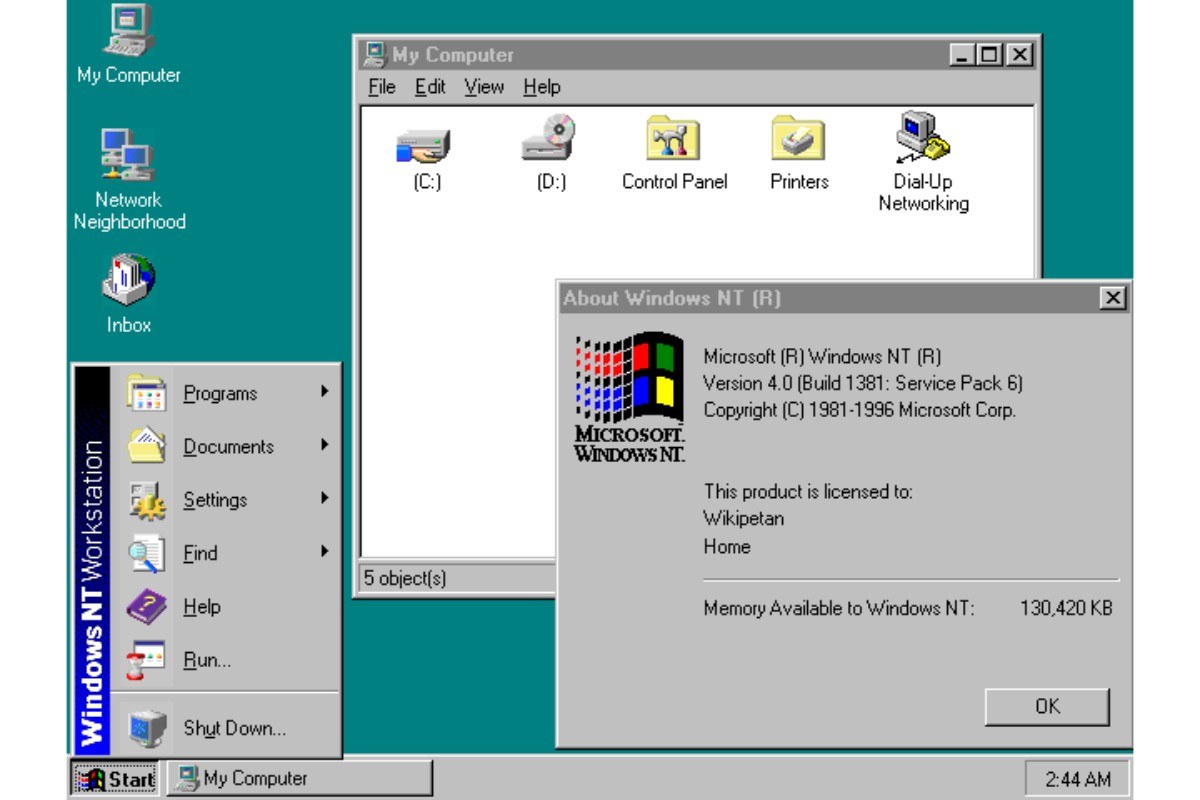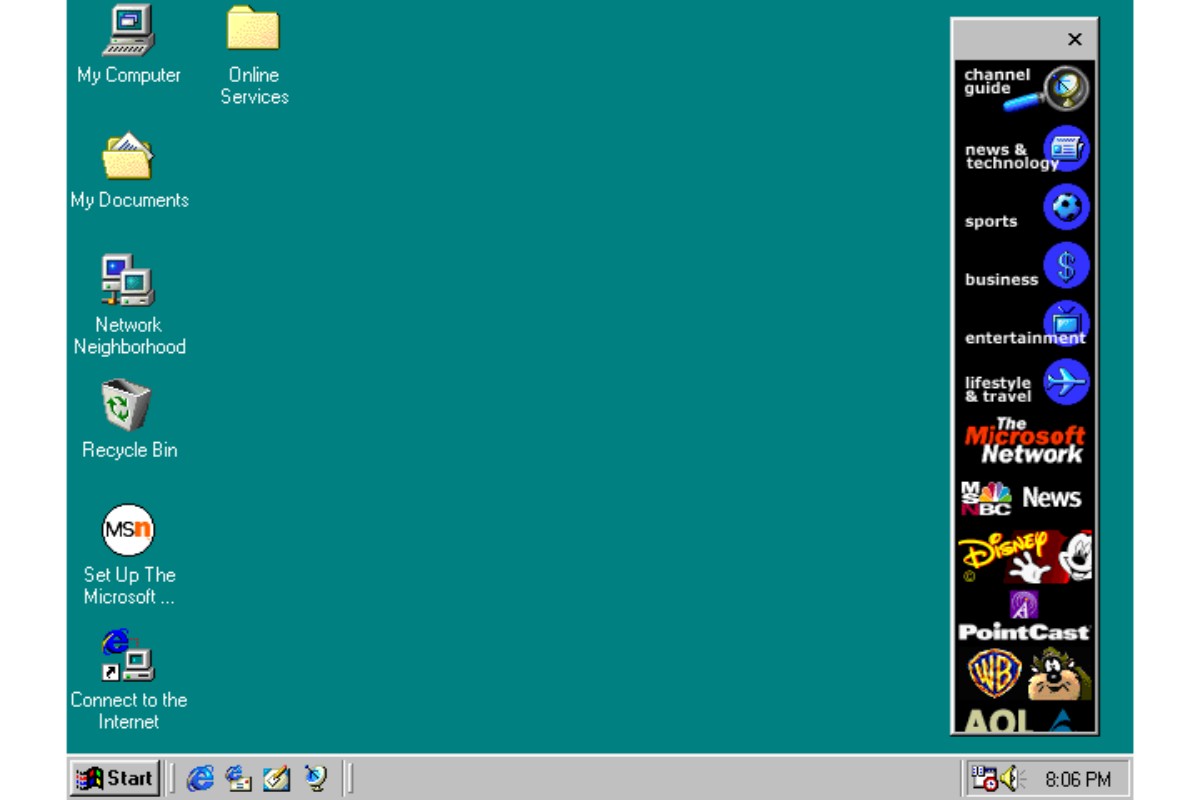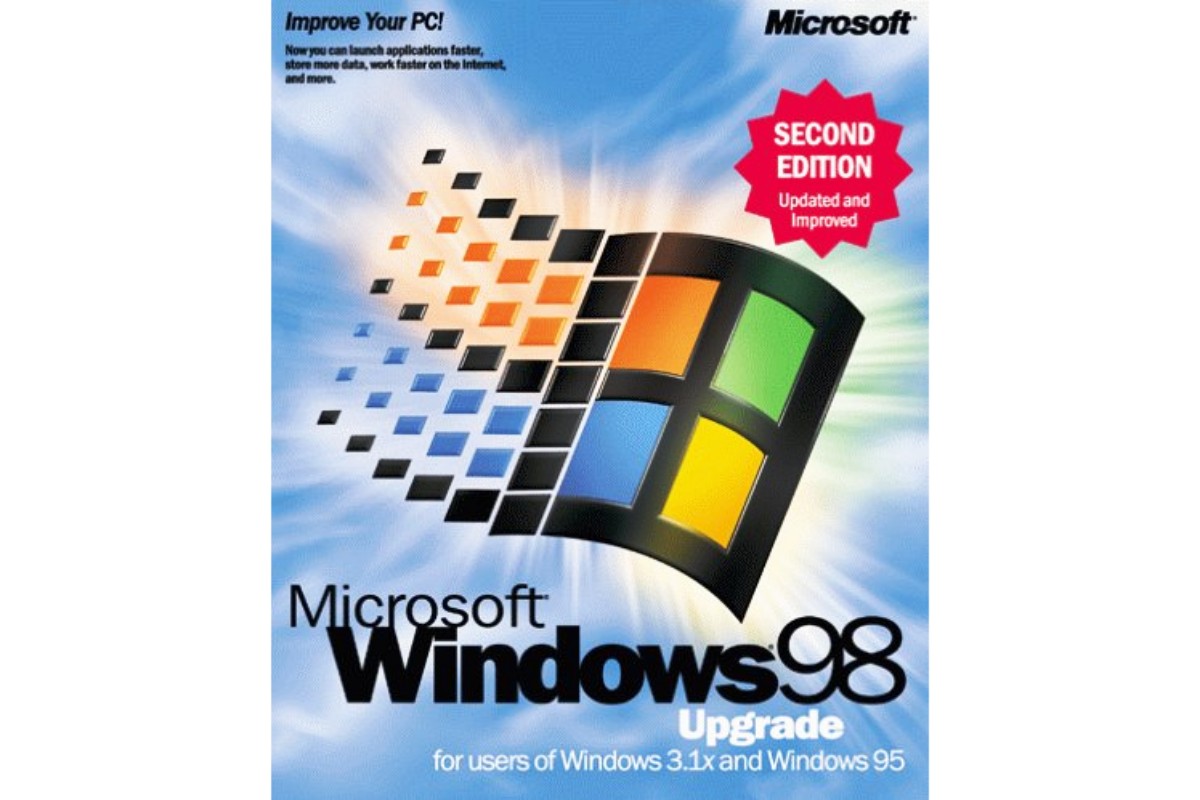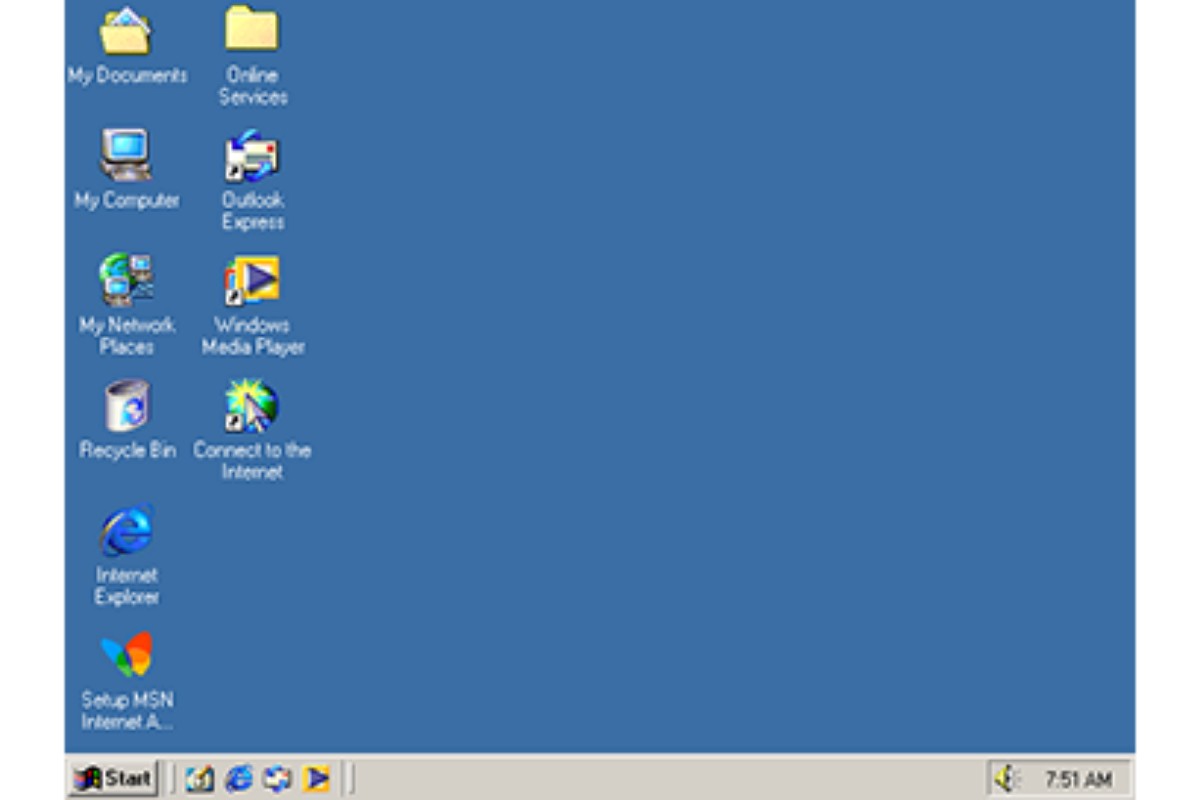History Of Microsoft Windows
Windows NT 4.0 (1996)
Microsoft updated Windows NT to version 4.0, which brought several enhancements. Windows NT 4.0 inherited its Start bar and GUI from Windows 95, which made the two OSes look similar. They were functionally different, however, and Windows NT 4.0 was much more server- and business-oriented.
Windows 95 was also much more user friendly than Windows NT 4.0; the latter did'nt include features such as Plug and Play (PnP) and Device Manager. Microsoft also used a new hardware abstraction layer on Windows NT 4.0 to reduce the likelihood of a system crash, but that also made installing new hardware more complicated. Further, just like Windows NT 3.1, Windows NT 4.0 had rather high system requirements. The OS could technically run with just 16MB of relatively expensive protected memory, but Microsoft recommended at least 32MB of RAM. It also required at least 110MB of hard drive space.
Although Windows NT 4.0 was outshined by Windows 95, it was fairly popular for businesses and servers. It was far more stable than Windows 95, and it was possible for the OS to run for several days or even weeks without crashing. Anyone who lived through the 1990s knows the same cannot be said for Windows 95.
MORE: The History of Nvidia GPUs
MORE: 30 Year History of AMD Graphics
Windows 98 (1998)
Windows 98 was essentially a polished version of Windows 95. It included several new applications such as Outlook Express, Microsoft Chat, NetMeeting, and NetShow Player. The OS also included FrontPage Express and a Personal Web Server with a built-in Web Publishing Wizard that allowed you to develop, publish, and host websites on your home PC. The UI introduced in Windows 95 was integrated with Internet Explorer and given several new features, as well. Forward and back buttons were added to ease file navigation, and Microsoft made it easier to minimize and launch new windows.
Microsoft also wanted to make Windows 98 more stable than its predecessor. By implementing numerous tweaks to the kernel, system drivers, system registry, and system memory management, Microsoft was successful in making Windows 98 less prone to crashing. This also helped to improve overall performance.
Get Tom's Hardware's best news and in-depth reviews, straight to your inbox.
Due to their user friendliness, affordability, and wide program support, Windows 95 and Windows 98 lead Microsoft to a place of dominance in the operating system market. Over the next few years, Microsoft further cement its dominance as numerous other companies went out of business.
MORE: 23 Years of Supercomputer Evolution
MORE: History Of Mechanical Keyboards
Windows 98 SE (1999)
Around the year 2000, Microsoft released four operating systems in quick succession. The first of these was Windows 98 SE, which was essentially just an updated version of Windows 98 with numerous bug fixes. This version also included a few new programs such as Windows Media Player, and it shipped with an updated version of Internet Explorer and the new DirectX 6.1 API. Windows 98 SE is considered by many to be the best DOS-based OS created by Microsoft. Although it is no longer supported by Microsoft itself, fans of the OS continue to support it with unofficial service packs that improve the operating system's feature set and stability.
MORE: The History of Intel CPUs
MORE: The History of AMD CPUs
Windows 2000 (1999)
Windows 2000 was released just a few months after Windows 98 SE and less than two weeks before the year 2000. (It was originally planned for release in 2000--hence the branding.) Essentially, the design goal for Windows 2000 was to add all of Windows 98's user-friendly features and programs to an OS based on Windows NT.
Windows 2000 received updated versions of most Windows 98 programs, and it shipped with several new features not found on any prior OS. It had unprecedented PnP support for USB and internal hardware devices. Like Windows NT 4.0, Windows 2000 was also rather stable. Microsoft also introduced Windows File Protection with Windows 2000, as well as enhanced software debug tools. This helped to improve system security and further improve overall stability.
Although Windows 2000 had a client-oriented version complete with games and multimedia features, it was mostly targeted as a server solution. The OS required just 32MB of RAM and 1GB of free storage space, but Microsoft recommended that users have 128MB of RAM and a 5GB HDD. Unlike Windows NT 4.0, Windows 2000 required at least an Intel Pentium 133MHz x86 CPU. With these easy-to-meet hardware requirements, Windows 2000 could cover all but the low-end home market, which was handled by Windows 98 SE.
This would be the last time Microsoft would use a general-purpose OS to target both servers and client workstation machines.
MORE: The History of Nvidia GPUs
MORE: 30 Year History of AMD Graphics
Windows Millennium Edition (2000)
Windows Millennium Edition (ME) was Microsoft's last DOS-based operating system and a direct successor to Windows 98 SE. To create Windows ME, Microsoft tweaked the Windows 98 SE kernel to limit software access to real-mode (DOS) in order to improve system stability and security, and to accelerate load times.
The UI was also updated to look similar to Windows 2000, and PnP and some other eatures were updated to have parity with Windows 2000. Ultimately, Windows ME proved to be a failure, and it may well be the least popular OS ever developed by Microsoft.
A key reason for Windows ME's failure in the market was its restricted real-mode access. Even in the year 2000, DOS-based software was heavily used; when Microsoft restricted real-mode access, it essentially removed backwards compatibility with a large number of DOS programs. Because of this issue, most people opted to either continue to use Windows 98 SE or switch to the more expensive Windows 2000.
MORE: 23 Years of Supercomputer Evolution
MORE: History Of Mechanical Keyboards
Windows XP (2001)
Windows XP was released in August 2001, and it was the fourth OS released by Microsoft in a relatively short two-year period. Microsoft developed Windows XP as both a consumer- and business-oriented solution that could handle any non-server aspect of the market. The OS was in many was an upgraded version of Windows 2000 with enhancements to essentially all aspects of the software, except the server utilities, which were not included with Windows XP.
It would take several pages to adequately cover all of the new features and improvements in Windows XP, but suffice it to say that the OS was more user-friendly and stable than its predecessors. It also further simplified the process of adding new hardware to a system.
Windows XP is arguably the most popular operating system ever produced. By the time Microsoft discontinued Windows XP, more than one billion copies had been sold. Later Microsoft operating systems struggled to pull users away from Windows XP, and it's actually still quite common to see the OS in use today, 15 years after its initial release.
MORE: The History of Intel CPUs
MORE: The History of AMD CPUs
Windows XP 64-bit Edition (2002)
Although Windows XP was primarily a 32-bit OS, Microsoft did develop 64-bit versions of the operating system. Windows XP 64-bit Edition was released in 2002, but it supported only Intel Itanium 64-bit processors. This version of Windows XP had a relatively short life due to its limited CPU support, and it was discontinued in 2005.
MORE: The History of Nvidia GPUs
MORE: 30 Year History of AMD Graphics
Windows XP Professional x64 Edition (2005)
Not long after Microsoft discontinued Windows XP 64-bit Edition, the company launched Windows XP Professional x64 Edition. Although the two OSes have similar names, they support completely different types of processors. Whereas Windows XP 64-bit Edition was designed for Itanium processors, Windows XP Professional x64 Edition supports x86-64 CPUs from both AMD and Intel. This eased adoption of 64-bit hardware and software, as the systems were capable of executing essentially any 32-bit x86 software.
MORE: 23 Years of Supercomputer Evolution
MORE: History Of Mechanical Keyboards
Windows Vista (2006)
Windows Vista was designed as a successor to Windows XP, but it was ultimately unsuccessful in luring large numbers of users away from the aging OS.
Vista was designed with an updated UI and a wide number of other improvements. The most critical update to Windows Vista was its increased software security. Ironically, the increased security safeguards are in part what lead to Vista's downfall. Software was run in a non-administrator protected mode by default, which caused some programs to malfunction. When you attempted to change system settings or access more advanced system controls such as those found in Control Panel, Vista required you to verify (several times) that you wanted to continue as an administrator and alter the settings.
The idea was that the verification prevented users from accidentally giving malicious software access to the rest of the system, but it also made it more difficult for experienced users to adjust settings and fix issues.
Vista is also criticized for being overall slower than Windows XP due in part to the aforementioned security improvements.
MORE: The History of Intel CPUs
MORE: The History of AMD CPUs
Windows 7 (2009)
Windows 7 was designed essentially as a heavily polished version of Windows Vista. Although Microsoft continued to push for increased security, the company also listened to feedback about Windows Vista and made Windows 7 less intrusive. You were still required to tell software to run in Administrator mode, but far less often. Performance was also significantly increased over Windows Vista and Windows XP. This performance gap is the most pronounced when you examine compute-intensive workloads that take advantage of new processor instructions found in Windows 7, such as Advanced Vector Extensions (AVX). Windows 7 was also more stable than its predecessors, which encouraged users to switch from the somewhat crash-prone Windows XP.
Windows 7 is regarded as Microsoft's second most successful OS of all time, behind XP. Although the OS struggled to pull users from Windows XP, it has had a steadily growing user base since its introduction and is widely used today.
-
nine9fingers You have to remember, Gates added nothing to PC-dos, Dos or Windows, all he was ever interested was collecting a penny from each USERReply -
shrapnel_indie Although you don't hear about it anymore, rumors existed of Bill Gates dumpster diving to get his BASIC code. It was also Microsoft's partnership with OEMs that ensured no other OS had a shot of becoming popular. MS had legal issues that appeared later for the practice as it forced OEMs who wanted to use MS Operating Systems into exclusivity.Reply
WARNING: Conspiracy theory found within comment.
I also still think the history between OS/2 and Windows NT is sketchy. Look at some of the naming conventions between parts (i.e. OS/2: HPFS, WinNT:NTFS), which I see is mentioned when talking about NT3.1. Also, look at how OS/2 didn't actually make major and needed improvements until after Microsoft ended the partnership between IBM and themselves. IMHO, MS was, despite what they told IBM, working on their OS/2 killer from day 1 (mostly planning, and learning at the earliest of stages.) Using the knowledge of IBM to learn and build from from the early stages, while making sure OS/2 wasn't good enough too compete when the time came. -
bit_user Too bad OS/2 got killed off. I knew some folks who really liked it.Reply
Also, please review ReactOS (http://reactos.org).
A couple points:
■ Windows for Workgroups 3.11 was a pretty major release, as I think it was first to integrate a TCP/IP stack. I had a friend who seemed unreasonably enthusiastic about it (he had a home network).
■ Windows NT introduced NTFS. Pretty obvious, but still... a big development. It also shipped with OpenGL support, as MS was intending to compete in the workstation segment. Fun fact: Michael Abrash optimized the NTFS code at MS, before joining ID Software to work on Quake. He's now Chief Scientist at Oculus/Facebook. He literally wrote the book on code optimization (The Zen of Code Optimization).
■Windows 95 ... System stability was significantly increased by running multiple virtual machines under the OS.
I'm no Windows architecture guru, but I think it's misleading to say it used VMs. These certainly weren't VMs in the way we now understand them. I think they were simply protected memory segments, with DOS boxes replicating the state of a DOS emulation layer. Also, Windows 3.1 (and possibly before) already used Protected Mode (anyone remember General Protection Faults?). Maybe Win95 made this compulsory?
■ Cool thing about Win95 is that programs always ran in 32-bit mode. So, you didn't need to do anything special to have up to 4 GB of flat address space in a single program. As a programmer, I considered this feature (as well as the promise of Direct 3D, which got dropped from the initial release) the most exciting development. Prior to that, it was annoying just to go beyond 64k (due to x86's 20-bit segmented addressing scheme).
■ Win95 bundled Internet Explorer, which was the main source of their anti-trust litigation. It looked like MS might've gotten split up, but George W. Bush put an end to the matter, when he took office.
■ I'm pretty sure WinNT 4.0 had a version of Direct 3D released for it. Win2k shipped with Direct 3D support.
■ I never ran WinME, but I think it was the last to ship without NTFS support.
■ Windows 8 introduced support for cross-platform apps that could be run on both ARM-based WinRT tablets/phones and x86_64 desktop PCs.
■ Not only does Windows 10 have embedded spy-ware, but it also integrates Windows Store.
Me: DOS 5.0 -> DOS 6.22 -> Win3.1 -> (briefly Win95) -> WinNT 4 Server -> Win2k Server -> WinXP Pro -> Win7 Pro
And I first booted Linux in 1991. -
synphul I ran most of these at one point in time. Before switching to xp I was happy to get rid of win9x and replace it with win2k, the nt based os's were a lot more stable and seemed to have better memory management.Reply
I think it's why xp was so successful, prior to xp there was a sort of division between home and business operating systems. The home varieties still being dos based with the business versions like win2k being nt based. Most things ran well on win2k but they didn't have quite the expansive program/driver support that the dos based had.
When xp rolled out it merged the best of both worlds, the stability of the nt kernel, improved memory management and the broader driver/app support of the 'home' flavors. Likely one of the best single moves MS made in their history of the windows os. -
Martell1977 What about Windows 3.11 for Workgroups? That was my first Windows operating system. I had DOS 6.22 with it, which is where I spent most of my time.Reply
Also, I was surprised there was no mention of when MS partnered (with no contract) with Apple and took the GUI/mouse interface, which ironically they got from Xerox.
Lastly, when did NTFS get introduced? And I was surprised there was no mention of how Windows XP was able to install/run on FAT32 or NTFS, but on NTFS it seemed more stable and ran faster. IIRC, Windows XP was the last Windows OS to use FAT32.
I remember someone telling me that Windows 98 got it's name from the fact that you had to reinstall it every 98 days as it degraded so fast...LMAO! -
bit_user Reply
There was an infamous bug in Win95 or Win98, where the machine would crash every 28 days when some timer overflowed.18858540 said:I remember someone telling me that Windows 98 got it's name from the fact that you had to reinstall it every 98 days as it degraded so fast...LMAO!
I think Win98 had some sort of background optimizer that ran defrag and maybe something else. I seem to recall it got a lot of bad press, at least until SE. I never ran either, as I was already on NT 4 Server, with a quad-CPU machine! -
Tom Griffin Seems to be missing Windows/286, Windows/386 and Windows NT 3.5x. Fun days using Microsoft Macro Assembler to access the Windows API.Reply -
turkey3_scratch I vaguely remember when I was like 3 years old on the Windows 2000 machine playing some Teletubbies game on the Internet. That old machine is still in the basement, I should open it up. I don't think it works anymore.Reply









